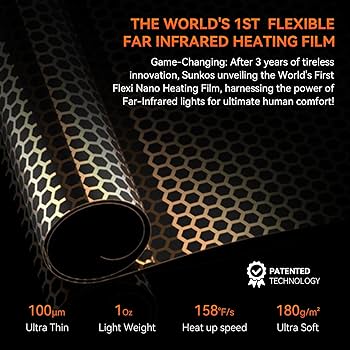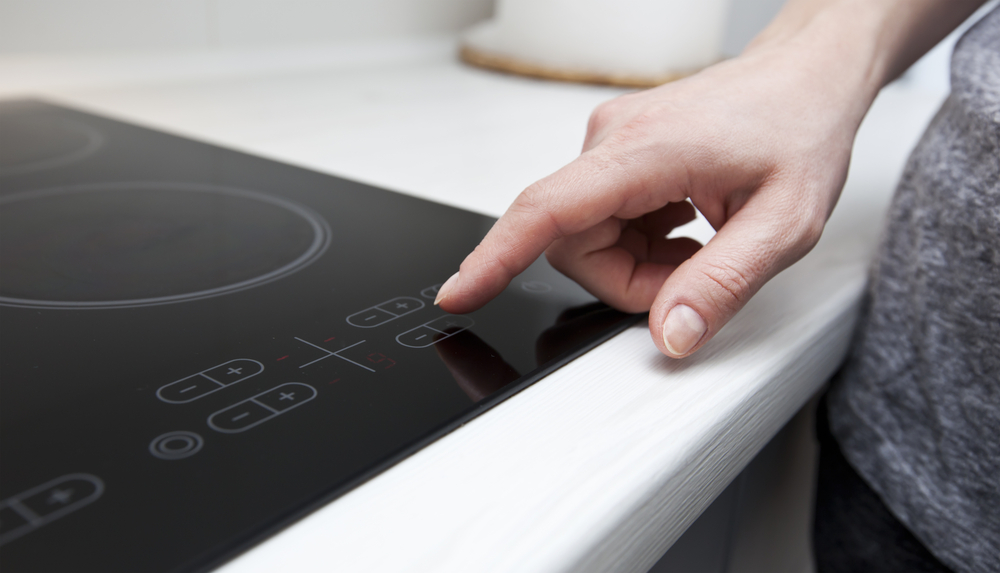An infrared heater uses minimal electricity, designed for efficiency and comfortable space heating while reducing energy consumption. Infrared heaters do not burn a lot of electricity, as they are designed to be incredibly efficient, providing cost-effective heating solutions.
They use as little energy as possible to keep your space warm and cozy. Infrared heating is a more economical option compared to other heating methods, such as gas furnaces. However, it is essential to choose infrared panels with safety features in mind to ensure optimal performance and user safety.
:max_bytes(150000):strip_icc()/spr-duraflame-3d-infrared-electric-fireplace-stove-at-amazon-rmarek-02-0200-2e0b58bafa4d47f4879c8df978a5a2f5.jpg)
Credit: www.thespruce.com

Unveiling The Power Consumption Of Infrared Heaters
Do infrared heaters burn a lot of electricity? Infrared heaters are designed to be highly efficient.
Infrared Heater Efficiency
- Infrared heaters use minimal energy while keeping your space warm.
- They are designed to operate efficiently and effectively.
Comparison With Other Heating Options
| Heating Option | Electricity Consumption |
|---|---|
| Infrared Heaters | Low energy consumption |
| Ceramic Heaters | Moderate energy usage |
| Baseboard Heaters | Higher electricity consumption |
Overall, using infrared heaters is a cost-effective and energy-efficient heating solution.
Factors Affecting Electricity Usage
An infrared heater’s electricity consumption is influenced by various factors that determine its efficiency and energy usage.
Wattage And Hours Used
The wattage of an infrared heater and the number of hours it operates play a crucial role in determining its electricity consumption.
Influence Of Heating Technologies
Different heating technologies, such as infrared, affect the amount of electricity consumed due to their unique heating mechanisms.
Cost Considerations
Infrared heaters are designed to be energy-efficient, using as little electricity as possible while keeping your space comfortable. The cost of running an infrared heater depends on its wattage and the hours it’s used per day. Overall, heating with infrared is generally cheaper compared to gas, but it’s essential to select models with safety features in mind.
Comparative Cost Analysis
Infrared heaters are cost-effective alternatives for heating spaces compared to traditional heating methods. They are efficient in converting energy into heat, reducing electricity consumption. With a comparative cost analysis, you can evaluate the cost benefits of operating an infrared heater in your space.
Safety And Energy Efficiency
Infrared heaters are designed to be energy-efficient, converting a high percentage of input energy into radiant heat. They are also safe to use, as they do not have exposed heating elements that can cause burns or fires. Safety and energy efficiency are key considerations when choosing an infrared heater for your heating needs.
When assessing the cost of operating an infrared heater, it’s crucial to consider factors such as comparative cost analysis and safety and energy efficiency. These elements not only impact your electricity bill but also provide insights into the overall cost-effectiveness of using an infrared heater.
Optimizing Energy Consumption
When it comes to using an infrared heater, optimizing energy consumption is key. By following a few tips and choosing the right heater for your needs, you can ensure that you are using your infrared heater efficiently and minimizing the amount of electricity it consumes. In this section, we will explore some tips for efficient usage and considerations for choosing the right heater.
Tips For Efficient Usage
Here are some tips to help you optimize the energy consumption of your infrared heater:
- Set the thermostat at an appropriate temperature: Set the thermostat to a comfortable temperature that suits your needs. Avoid setting it too high, as this can lead to unnecessary energy consumption.
- Use a timer: Consider using a timer to schedule the operating hours of your infrared heater. This way, you can ensure that it is only running when needed, saving on energy consumption.
- Insulate your space: Properly insulating your space can help retain heat and reduce the workload on your infrared heater. This means that it doesn’t have to work as hard to maintain the desired temperature, resulting in lower energy usage.
- Utilize zone heating: Instead of heating the entire house, consider using your infrared heater to heat specific zones or rooms that are frequently used. This targeted approach can save energy by avoiding heating areas that are not in use.
- Keep doors and windows closed: To prevent heat from escaping, make sure to keep doors and windows closed while your infrared heater is running. This helps maintain the temperature in your space, reducing the need for the heater to work harder.
Choosing The Right Heater For Your Needs
When selecting an infrared heater, it is important to consider various factors to ensure optimal energy consumption:
- Size and capacity: Choose a heater with an appropriate size and capacity for the space you intend to heat. Selecting a heater that is too small may result in the need for it to operate at maximum capacity, consuming more electricity.
- Energy efficiency rating: Look for heaters with high energy efficiency ratings. These models are designed to deliver the maximum amount of heat while using minimal energy.
- Thermostat control: Opt for a heater with a thermostat control feature. This allows you to set and maintain your desired temperature, avoiding unnecessary energy usage.
- Safety features: Ensure that the heater you choose has built-in safety features such as overheating protection and tip-over switches. These features not only provide peace of mind but also prevent potential accidents that can lead to energy wastage.
By implementing these tips and considering the factors mentioned above, you can effectively optimize the energy consumption of your infrared heater. This not only helps reduce your electricity bills but also contributes to a more sustainable and eco-friendly approach to heating your space.
Final Thoughts On Infrared Heating
Infrared heaters are known for their energy efficiency, utilizing minimal electricity while ensuring a cozy space. Compared to traditional heaters, infrared technology offers cost-effective heating solutions for homes. Choose infrared panels with safety features for optimal performance and savings.
Environmental Impact
Infrared heaters have gained popularity not just for their energy-saving capabilities, but also for their positive environmental impact. Unlike traditional heaters that rely on fossil fuels or release harmful emissions, infrared heaters use electricity to generate heat. This means they do not contribute to air pollution or emit greenhouse gases, making them a much greener heating option. Additionally, the infrared heat produced by these heaters is gentle and doesn’t dry out the air or reduce humidity levels, promoting a healthier indoor environment.Long-term Cost Benefits
When it comes to the cost savings of infrared heaters, the benefits are two-fold. First, these heaters are incredibly efficient, using as little energy as possible to provide effective heating. This means you’ll see a significant reduction in your electricity bill compared to using traditional heating methods. Secondly, infrared heaters offer zone heating, allowing you to heat specific areas of your home rather than wasting energy on heating the entire space. By targeting the areas you frequent the most, you can further reduce energy consumption and save even more money in the long run. To put these cost benefits into perspective, let’s take a look at a comparison between infrared heaters and traditional heaters:| Infrared Heater | Traditional Heater | |
|---|---|---|
| Initial Cost | $$ (varies) | $$ (varies) |
| Energy Efficiency | High | Low to Medium |
| Operating Cost | Low | High |
| Lifespan | Long | Short to Medium |

Credit: www.electricrate.com

Credit: www.amazon.com
Frequently Asked Questions On How Much Electricity Does An Infrared Heater Use
Do Infrared Heaters Burn A Lot Of Electricity?
Infrared heaters are energy-efficient and designed to use minimal electricity while effectively heating your space.
Is It Cheaper To Run An Infrared Heater Than The Furnace?
Yes, running an infrared heater is cheaper than using the furnace due to its energy efficiency.
How Much Does It Cost To Run A 1500 Watt Infrared Heater A Day?
The cost of running a 1500 watt infrared heater for a day depends on your electricity rate. Approximate cost can be calculated by multiplying the wattage (1500) by the number of operating hours and then dividing by 1000 to get kilowatt-hours.
Multiply this by your electricity rate to get the total cost per day.
Is Infrared Heating Expensive To Run?
Infrared heaters are not expensive to run. They are designed to use as little energy as possible while still keeping your space comfortable. Infrared heating is much cheaper compared to gas heating. Just make sure to choose infrared panels that are manufactured with safety in mind.
How Much Electricity Does An Infrared Heater Use?
Infrared heaters are incredibly efficient and designed to use as little energy as possible while still keeping your space comfortable.
Conclusion
Infrared heaters are highly efficient and designed to use minimal energy while keeping your space comfortably warm. They offer cost-effective heating compared to traditional methods. When exploring heating options, considering an infrared heater can help you save on electricity bills while ensuring a cozy environment.